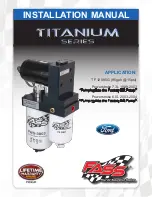
CAUTION! (Continued)
•
Use on Rear Wheels only.
•
Do not drive for a prolonged period on dry
pavement.
•
Observe the tire chain manufacturer’s in-
structions on method of installation, oper-
ating speed, and conditions for use. Always
use the lower suggested operating speed
of the chain manufacturer if different from
the speed recommended by the manufac-
turer.
These cautions apply to all chain traction de-
vices, including link and cable (radial) chains.
TIRE ROTATION
RECOMMENDATIONS
The tires on the front and rear of your vehicle
operate at different loads and perform different
steering, handling, and braking functions. For
these reasons, they wear at unequal rates.
These effects can be reduced by timely rotation
of tires. The benefits of rotation are especially
worthwhile with aggressive tread designs such
as those on On/Off Road type tires. Rotation will
increase tread life, help to maintain mud, snow,
and wet traction levels, and contribute to a
smooth, quiet ride.
Refer to the “Maintenance Schedule” for the
proper maintenance intervals. The reasons for
any rapid or unusual wear should be corrected
prior to rotation being performed.
The suggested rotation method is the “forward-
cross” shown in the following diagram. This
rotation pattern does not apply to some direc-
tional tires that must not be reversed.
CAUTION!
Proper operation of four-wheel drive vehicles
depends on tires of equal size, type and
circumference on each wheel. Any difference
in tire size can cause damage to the transfer
case. Tire rotation schedule should be fol-
lowed to balance tire wear.
TIRE PRESSURE MONITOR SYSTEM
(TPMS)
The Tire Pressure Monitor System (TPMS) will
warn the driver of a low tire pressure based on
the vehicle recommended cold placard pres-
sure.
The tire pressure will vary with temperature by
about 1 psi (6.9 kPa) for every 12°F (6.5°C).
This means that when the outside temperature
decreases, the tire pressure will decrease. Tire
pressure should always be set based on cold
inflation tire pressure. This is defined as the tire
pressure after the vehicle has not been driven
for at least three hours, or driven less than
1 mile (1.6 km) after a three hour period. The
cold tire inflation pressure must not exceed the
Tire Rotation
193
Summary of Contents for Grand Cherokee
Page 1: ...Cherokee O P E R AT I N G I N F O R M AT I O N...
Page 2: ......
Page 3: ......
Page 4: ......
Page 6: ...2...
Page 11: ...7...
Page 77: ...73...
Page 78: ...74...
Page 79: ...75...
Page 122: ...118...
Page 126: ...INSTRUMENT CLUSTER 122...
Page 141: ...Compass Variance Map 137...
Page 150: ...146...
Page 154: ...Control Setting Suggestions for Various Weather Conditions 150...
Page 300: ...296...
Page 301: ...297...
Page 302: ...298...
Page 303: ...10 INDEX 299...
Page 314: ......
Page 315: ...Chrysler Group LLC Cherokee 12KK74 126 ENG AA Printed in Europe 12...
















































